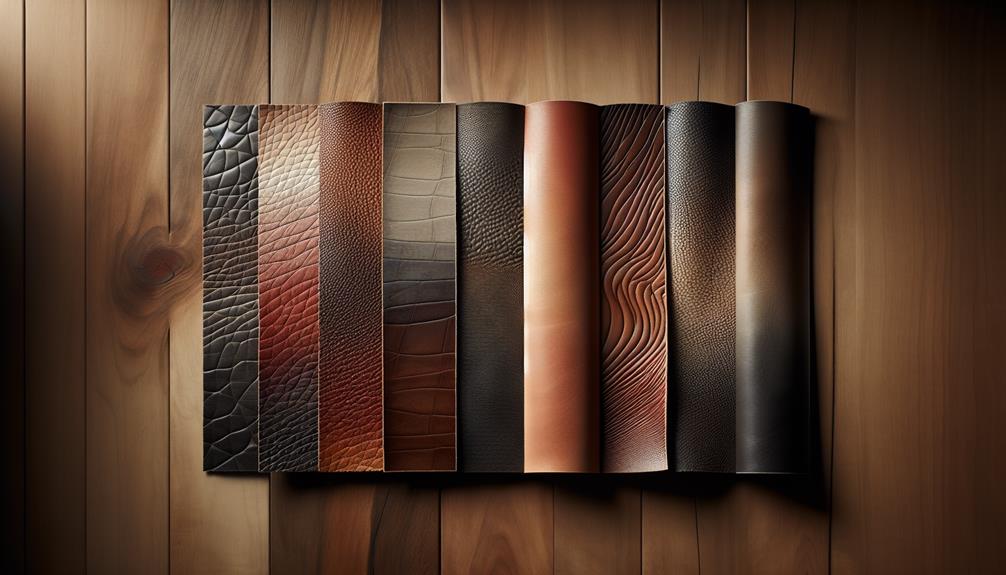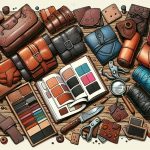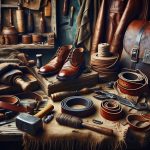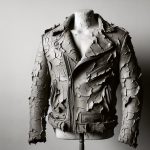In my experience, the five grades of leather range from high quality to more economical options. At the top, there's full grain leather, which keeps the natural grain intact and ages beautifully. Next is top grain leather, which is refined and smooth since it's buffed. Genuine leather, a lower grade, comes from the bottom cut of the hide and is heavily processed. Then there's split grain leather, which is more affordable but less durable. Lastly, bonded leather mixes real leather scraps with synthetic materials, making it the least durable but highly affordable. Stick around, and I'll show you how each type is unique in its applications.
Table of Contents
Key Takeaways
- Full Grain Leather: Highest quality, retains natural grain, develops a patina, durable and unique.
- Top Grain Leather: Refined second-highest grade, smooth finish, popular in high-end products, stain-resistant.
- Genuine Leather: Lower quality, made from the bottom cut, heavily processed, less durable.
- Split Grain Leather: Affordable, lacks natural markings, coated for better appearance, prone to wear.
- Bonded Leather: Made with leather scraps and synthetics, cheapest, prone to cracking and peeling.
Full Grain Leather Explained
Full Grain Leather is the top-tier grade, keeping its natural grain completely intact. It's the cream of the crop when it comes to leather grades, far surpassing others like genuine leather in quality and durability. I've come to appreciate full grain leather not just for its robustness but also for how it ages. Unlike other materials that wear down, this leather develops a rich patina, enhancing its aesthetic appeal over time.
The unique thing about full grain leather is its natural blemishes and grain variations. These aren't defects; rather, they're proof of the leather's authenticity and premium quality. Each piece tells a story, marked by distinct patterns that can't be replicated. This quality makes each product unique, a one-of-a-kind piece that stands out.
As someone who values high-quality craftsmanship, I always recommend full grain leather for products that need to withstand frequent use. It's incredibly durable, capable of outlasting other types of leather by years. Whether it's a wallet, belt, or jacket, choosing full grain ensures you're investing in something that not only lasts but also gets better with age.
Understanding Top Grain Leather
While full grain leather holds the top spot for natural quality, top grain leather is its close contender, known for its refinement and smooth finish. As the second-highest grade of leather, top grain leather is meticulously refined to enhance both workability and uniformity. This process typically involves the leather being buffed or sanded, which effectively removes any surface imperfections and results in its notably sleek surface.
Top grain leather is a popular choice for crafting high-end leather products due to its impressive balance of quality and durability. Although it's not as tough as full grain leather, it compensates with a more consistent and flawless appearance. This makes it particularly appealing for luxury items where aesthetic and tactile appeal are paramount.
Additionally, top grain leather stands out for its practical advantages. It offers good stain resistance, which is a significant benefit for everyday use items like sofas or jackets. Its refined surface doesn't just look good; it also holds up well against wear and tear, maintaining its integrity over time. This blend of aesthetic appeal and functional resilience makes top grain leather a top choice for those who value both style and substance in their leather goods.
The Basics of Genuine Leather
Genuine leather, often labeled in marketing to suggest higher quality, actually represents a lower grade of leather made from the bottom cut of the hide. When we hear 'genuine leather,' it's easy to think it means the best, but that's not the case. It's a clever marketing term that can be quite misleading. Genuine leather is considered the lowest in leather grades and is typically found in cheaper products.
This type of leather is heavily processed to enhance its appearance and durability but doesn't match up to higher grades like top grain or full grain leather. It's made from the bottom cut, which is inherently weaker and less durable. Because it's less costly to produce, genuine leather is often used in making items where cost savings are a priority over quality.
Furthermore, genuine leather is frequently confused with bonded leather, which is even lower in quality. Bonded leather consists of leftover scraps fused together, not a solid piece of hide like genuine leather. However, both are far from premium materials and are often used interchangeably in marketing to appeal to consumers who mightn't understand the difference.
Insights on Split Grain Leather
After discussing genuine leather, let's now focus on split grain leather, which is another common but lower quality material used in many leather products. Split grain leather, often just called 'split,' is what remains after the top layer of the hide has been removed. This type of leather is popular because it's more affordable compared to higher grades. However, it's important to note that split lacks natural markings, which affects its overall appeal and durability.
To compensate for these drawbacks, manufacturers often coat split leather with polymers and emboss it to create more appealing textures. These enhancements can mimic higher-quality leather at a glance, but don't be fooled—split grain leather typically doesn't hold up well over time. It's prone to wear and tear because it lacks the tough, outer layer that protects higher-grade leathers.
Additionally, split leather isn't very breathable, leading to less comfort for items like footwear or clothing. While it may be a cost-effective choice for those on a budget, its short lifespan and lower durability make it less ideal for anyone looking for long-term value in leather goods.
Decoding Bonded Leather
Let's dive into bonded leather, a popular yet less durable choice known for its mixed composition of real leather and synthetic materials. Bonded leather includes about 10-20% genuine leather mixed with polyurethane binding. This blend is what sets it apart, contributing to its uniform appearance that lacks the natural imperfections you'd see in full-grain leathers.
One of the biggest perks of bonded leather is its affordability. It's significantly cheaper because it's thinner and not purely made from animal hide. However, this cost saving comes with a trade-off. Bonded leather is notorious for being less durable. Over time, you might notice it cracking and peeling, which can be a real headache.
Dealing with these issues isn't straightforward either. When it comes to cleaning, you have to be extra careful. Regular cleaners won't do the trick, especially with the cracking and peeling. You'll need something like Leather Honey Leather Cleaner, designed specifically for such materials. This cleaner helps manage the cleaning challenges without exacerbating any damage.
Frequently Asked Questions
What Is the Best Grade of Leather?
The best grade of leather is full grain. It's highly durable, tough, and ages beautifully, gaining a patina that enhances its character. It's perfect for items you want to last a long time.
What Is the Cheapest Grade of Leather?
The cheapest grade of leather is bonded leather. It's made with minimal real leather, mixed with PVC and fiber. It's less durable and feels artificial, commonly used in low-cost furniture and bags.
What Are 5 Different Types of Leather?
I'll explain the five types: Full Grain is the toughest, Top Grain is smoother, Genuine Leather is lower quality, Split Grain is even lower, and Bonded Leather mixes scraps for the cheapest option.
What Is Poor Quality Leather?
Poor quality leather, like bonded leather, is made from scraps with minimal real leather. It's less durable, prone to damage, and lacks the natural characteristics and smell of higher quality leather.
- What Types of Clothing Are Nylon? - April 19, 2024
- What Are the 5 Types of Nylon? - April 19, 2024
- What Are the Characteristics of Nylon Fabric? - April 19, 2024








